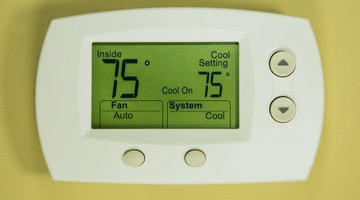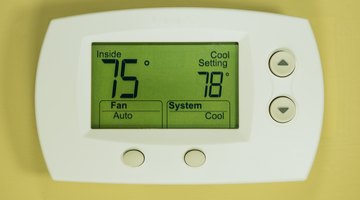The Best Thermostat Settings
As outside temperatures change, improperly set thermostats can diminish household comfort zones. Energy Star states that as of 2010, most homeowners pay in excess of $2,200 annually on energy bills with almost half of those expenses identified as cooling and heating.

The company estimates that maintaining energy-efficient thermostat settings can save $180 per year. Programmable thermostats operate under the assumption that the house is devoid of people during weekdays and occupied at night and on weekends; but modern work schedules are no longer so rigid so your thermostat may be heating and cooling at times not beneficial to you.
Settings for the Summer Months

Set your thermostat for 78 degrees Fahrenheit or 26 degrees Celsius when someone is at home. If you know no one will be home, turn the thermostat up. According to the U.S. Department of Energy, the warmer your home is inside, the slower outside heat penetrates the interior of your home. Keeping the home warmer when not in use will save money on your energy bill. Personal temperature comfort levels vary, but air condition settings between 76 degrees Fahrenheit and 78 degrees Fahrenheit provide optimal cooling savings. We Energy estimates a 10 percent savings on your cooling bill when your thermostat is set at 76 degrees Fahrenheit or higher.
Settings for the Winter Months

The best thermostat setting for your home during the winter months is 68 degrees Fahrenheit when occupied. The U.S. Department of Energy recommends lowering the thermostat when no one is home. A household heating bill can drop 10 percent annually by lowering your thermostat 10 to 15 degrees from your current preferred setting for a period of eight consistent hours daily. Furnaces do not compensate for a lower thermostat setting by working harder. Furnaces continue to warm a building at the same speed regardless of the temperature setting. When the inside temperature is lower, heat seeps from your home at a slower rate. One thing to remember, however, is you should not set a thermostat lower than 40 degrees Fahrenheit, especially if you have pets or houseplants. Set your thermostat no lower than 50 degrees Fahrenheit to protect plants and prevent pipe problems in extreme climates.
Settings for Heat Pumps

Heat pumps do not work the same way as a gas or electric, or even coal furnace does. These appliances both heat and cool a home by changing the way they operate based on the thermostat setting. One common mistake with heat pumps is setting the thermostat on emergency heat by accident. When temperatures reach extreme levels of cold -- 35 degrees Fahrenheit or below -- the heat pump must use a backup heating source. This backup heating source will run continuously to heat the home. Setting your heat pump on emergency heat will run the unit constantly, increasing your energy bill significantly. Only use the emergency heat feature in extreme weather or when the unit shows visible ice accumulation. The U.S. Department of Energy recommends a consistent, moderate heat pump thermostat setting during each season for the most energy-efficient usage. Set the thermostat on the highest comfortable setting in the summer and the lowest comfortable setting in the winter. Various manufacturers recommend a setting of 78 degrees Fahrenheit or higher for air conditioning and 70 degrees Fahrenheit or lower for heating purposes.
The Drip Cap
- As outside temperatures change, improperly set thermostats can diminish household comfort zones.
- One thing to remember, however, is you should not set a thermostat lower than 40 degrees Fahrenheit, especially if you have pets or houseplants.
- Set your thermostat no lower than 50 degrees Fahrenheit to protect plants and prevent pipe problems in extreme climates.
- These appliances both heat and cool a home by changing the way they operate based on the thermostat setting.
- Setting your heat pump on emergency heat will run the unit constantly, increasing your energy bill significantly.
- The U.S.
- Department of Energy recommends a consistent, moderate heat pump thermostat setting during each season for the most energy-efficient usage.
References
Resources
Writer Bio
Louise Harding holds a B.A. in English language arts and is a licensed teacher. Harding is a professional fiction writer. She is mother to four children, two adopted internationally, and has had small businesses involving sewing and crafting for children and the home. Harding's frugal domestic skills help readers save money around the home.
Photo Credits
- Heather Orlando/Demand Media
- Heather Orlando/Demand Media
- Heather Orlando/Demand Media
- Heather Orlando/Demand Media
- Heather Orlando/Demand Media
More Articles



